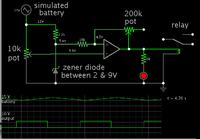dangerboybb
Newbie level 3
Not sure if this is the right forum, my apologies if not. I'm a novice when it comes to electrical stuff, and attempting to work on a home battery system. The charging source is an electric motor connected to my generator that will charge the battery bank. I wanted to find out if anyone had any ideas, could point me in the right direction on what I need in order to automate turning the motor on when the voltage in the battery bank gets low. The charge controller to the battery bank is a simple one, and only has a load cutoff, nothing beyond that. I could possibly put in some kind of timer relay, but was hoping for a more intelligent solution like a voltage range detection kind of a relay. Trying to search for what I need with limited knowledge just generates more questions, and it's very confusing with so many unfamiliar acronyms. I'm not even sure I'm heading down the right path. I would be most gracious for any help. Again, my apologies if this is in the wrong forum. Thank you!!
